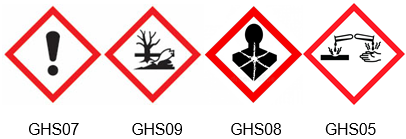The CLP Regulation (Regulation (EC) No 1272/2008 on Classification, Labelling and Packaging of substances and mixtures) is an EU law that aligns the European system with the Globally Harmonised System (GHS) developed by the United Nations. Its purpose is to ensure that hazards associated with chemicals are clearly communicated through standardized labelling and classification practices across all EU Member States.
CLP replaces the older Dangerous Substances and Dangerous Preparations Directives and works alongside the REACH Regulation (EC No 1907/2006) to ensure the safe use of chemicals, protect human health and the environment, and support free trade through consistent hazard communication.
CLP applies to all chemical substances and mixtures placed on the EU market. It requires manufacturers and importers to:
- Classify substances and mixtures according to their hazards.
- Label them clearly and consistently using standardized elements.
- Package them safely.
What needs to be written on my CLP label?
The required CLP label elements can be found in Section 2.2 of the Safety Data Sheet (SDS). Your label must include, where applicable:
- Hazard pictograms
- Signal word (“Warning” or “Danger”)
- Hazard statement(s) (e.g., H317, H411)
- Names of hazardous components contributing to the classification
- UFI code (if applicable—see below)
These elements must be clearly visible on the product label. For scented products such as candles, wax melts, diffusers, and sprays, correct labelling is mandatory when the final product is classified as hazardous.
UFI Code – What You Can and Cannot Do
The UFI (Unique Formula Identifier) is a 16-digit alphanumeric code that links a hazardous mixture to a registered Poison Centre Notification (PCN). From January 1, 2025, the UFI becomes mandatory for all hazardous consumer and professional-use mixtures sold in the EU.
If you are using one of our fragrance oils without modifying it, and the final product you create (e.g., a candle or diffuser) is classified as hazardous, then:
✅ You may use the UFI shown on our SDS, only if:
- We (the supplier) have submitted a valid PCN to the ECHA Poison Centre Notification portal, and
- You do not mix the fragrance oil with any other hazardous ingredients or alter its composition.
In this case, no further PCN submission is needed on your part—just make sure the UFI is clearly shown on your label, prefixed by “UFI:” (e.g., UFI: XYZ1-ABCD-EFGH-1234).
❌ However, if you:
- Combine our fragrance oil with other hazardous substances (e.g., solvents, thinners)
- Resell or repackage or rebottle our fragrance oil
- Mix more than one fragrance oil,
- Or otherwise change the hazard profile of the final product,
…you are creating a new hazardous mixture, and you must:
- Generate your own UFI for the final product, and
- Submit your own Poison Centre Notification (PCN) through the ECHA PCN portal.
⚠️ If your final product is not classified as hazardous, then no UFI or PCN submission is required, even if it contains fragrance oil.
Why We No Longer Display Thresholds for UFI-Free Use
Many customers ask whether a fragrance oil can be used below a certain percentage to avoid the need for CLP labelling or a UFI. While this can be true in theory, the actual classification of the final product depends on all ingredients—not just the fragrance.
Even small amounts of classified fragrances can trigger labelling requirements if combined with other hazardous ingredients. Therefore, we’ve removed simplified percentage indicators from our product pages to avoid confusion or false assumptions.
To determine whether your product is classified as hazardous, you must advice the CLP Information provided under each product description in the “Related Documents” tab.
SDS, IFRA & Allergen Declarations
All regulatory documents—Safety Data Sheets (SDS), IFRA Certificates, and Allergen Declarations—are available for download on each product page under the “Related Documents” tab.
- Our SDS documents describe the fragrance oil as a raw material at 100% concentration.
- IFRA Certificates specify the maximum safe usage level per application type (e.g., candles, soaps, perfumes).
- Allergen declarations follow the latest EU regulation and reflect substances present above the required thresholds.
📩 If you require documents calculated at a custom dilution (e.g., 10% in diffuser base), we’re happy to generate them upon request, though if you only need them only for CLP labeling please advise the CLP info section below the “Related Documents” tab.
Disclaimer
The information provided here is accurate to the best of our current knowledge and is offered in good faith. However, it only reflects the classification and regulatory contribution of the fragrance oil itself.
The ultimate legal responsibility for classifying, labelling, and notifying the final product lies with the person or business placing that product on the market. You must assess your full formulation using all available data to determine your obligations under the CLP Regulation.
Appendix for CLP Hazard Statements
H302: Harmful if swallowed
H304: May be fatal if swallowed and enters airways.
H315: Causes skin irritation.
H317: May cause an allergic skin reaction.
H319: Causes serious eye irritation.
H334: May cause allergy or asthma symptoms or breathing difficulties if inhaled.
H335: May cause respiratory irritation.
H336: May cause drowsiness or dizziness.
H361: Suspected of damaging fertility or the unborn child.
H372: Causes damage to organs through prolonged or repeated exposure.
H410: Very toxic to aquatic life with long-lasting effects.
H411: Toxic to aquatic life with long-lasting effects.
H412: Harmful to aquatic life with long-lasting effects.
Appendix for CLP Hazard Pictograms

